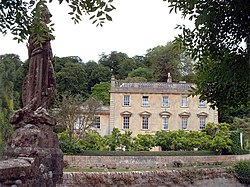Iford Manor: Difference between revisions
Created page with "{{Infobox house |name=Iford Manor |county=Wiltshire |picture=Iford 2.jpg |picture caption=Iford Manor on the River Frome |os grid ref=ST802589 |latitude=51.32885 |longitude=-2..." |
No edit summary |
||
| Line 12: | Line 12: | ||
|website=[http://www.ifordmanor.co.uk www.ifordmanor.co.uk] | |website=[http://www.ifordmanor.co.uk www.ifordmanor.co.uk] | ||
}} | }} | ||
'''Iford Manor''' is a manor house near [[Bradford on Avon]] in Wiltshire. It stands on the steep, south-facing slope of the [[River Frome|Frome valley]]. | '''Iford Manor''' is a manor house near [[Bradford on Avon]] in Wiltshire. It stands on the steep, south-facing slope of the [[River Frome, Somerset|Frome valley]]. | ||
The origins of the house may be as early as late 15th century. The classical façade was added around 1730, and the hanging woodlands above the garden were planted later in the 18th century.<ref name=EHgarden>{{NHLE|1000438|Iford Manor Park and Gardens}}</ref> | The origins of the house may be as early as late 15th century. The classical façade was added around 1730, and the hanging woodlands above the garden were planted later in the 18th century.<ref name=EHgarden>{{NHLE|1000438|Iford Manor Park and Gardens}}</ref> | ||
Latest revision as of 22:37, 1 April 2021
| Iford Manor | |
| Wiltshire | |
|---|---|
 Iford Manor on the River Frome | |
| Location | |
| Grid reference: | ST802589 |
| Location: | 51°19’44"N, 2°17’8"W |
| History | |
| Country house= | |
| Information | |
| Website: | www.ifordmanor.co.uk |
Iford Manor is a manor house near Bradford on Avon in Wiltshire. It stands on the steep, south-facing slope of the Frome valley.
The origins of the house may be as early as late 15th century. The classical façade was added around 1730, and the hanging woodlands above the garden were planted later in the 18th century.[1]
Today the house is a Grade II* listed building [2] It is known for its Peto Gardens and as the venue of the annual Iford Arts Festival.
Gardens

Iford is best known for its gardens, which are designated Grade I in the National Register of Historic Parks and Gardens. The gardens are known as the Peto Gardens: they were designed during the early part of the 20th century by the garden architect Harold Peto who lived at Iford from 1899 until his death in 1933 during which time he built up an extensive collection of artefacts, brought back from his travels abroad.[1]
Peto's great love of the Italian garden style is plainly evident at Iford, where flowers occupy a subordinate place amongst the more structural elements of cypress, statuary, broad walks and pools.[3]
A number of plants of particular interest can be found at Iford: standard Wisteria sinensis blossoms across much of the front of the house and up flights of steps linking the terraces (particularly good in late May); Phillyrea latifolia; Buxus sempervirens grows in wild tree form in the woods above the house and is extensively used in the gardens as a structural plant; Cupressus sempervirens; Hemerocallis citrina, the scented daylily; the naturalised Martagon lily.
In addition to his planting and structural work, Peto created a number of architectural garden features, which remain well preserved.[3] Behind the manor house, to which he added a loggia, terraces lead up to the main lawn. Alongside the lawn he built a lily pool, a colonnade-lined Great Terrace, and the Cloisters, a Grade II* listed[4] Italianate courtyard surrounded by an arcade,[1] which was his "Haunt of Ancient Peace" where he displayed many of his treasures.
Higher up the hillside, Peto built more terraces with retaining walls, and a pavilion called the Casita.[1]
Iford Manor was the recipient of the Historic Houses Association/Christie's Garden of the Year Award in 1998.[5]
Arts and filming
Each summer the Iford Arts Festival has a three-month season of opera, jazz and other concerts in the gardens, making use of the Cloisters[6] and the Casita as performance spaces.[7]
Iford Manor has been used for filming on a number of occasions. In 2008 the gardens and the Cloisters were used as the venue for the wedding sequence in Episode 1 of the second series of Mistresses.[8]
Iford Manor SSSI
The roof spaces of Iford Mill Barn are used as a summer breeding roost by Greater Horseshoe Bats, one of very few 14 known roosts for this species in Britain, and a large one with over 250 individual Greater Horseshoes recorded each summer. Because of this, the buildings and a small area of land surrounding them, 1.0 acre, were notified as a 'biological Site of Special Scientific Interest' in 1996.
The Site of Special Scientific Interest includes an orchard, where Daubenton's Bat and Noctule Bat roost.[9]
Pictures
-
The bridge
-
View from the bridge
-
Entrance gates
Outside links
- Iford Manor
- Iford Arts – an organisation that runs musical and arts events at Iford
- Iford Manor entry from The DiCamillo Companion to British & Irish Country Houses
- English Nature (SSSI information)
References
- ↑ 1.0 1.1 1.2 1.3 National Heritage List 1000438: Iford Manor Park and Gardens
- ↑ National Heritage List 1158288: Iford Manor
- ↑ 3.0 3.1 Garmey, Jane (1 March 2008). "Architect of a Lovely Garden". Wall Street Journal. http://online.wsj.com/article/SB120431754467103615.html. Retrieved 16 July 2013.
- ↑ National Heritage List 1021878: The Cloisters, Iford Manor
- ↑ "The Peto Garden at Iford Manor". Historic Houses Association. http://www.hha.org.uk/Property/1059/The-Peto-Garden-at-Iford-Manor. Retrieved 18 July 2013.
- ↑ White, Anna (May 2013). "Making Music in Paradise". Bath Magazine: p. 22. http://issuu.com/mcpublishing/docs/bathmag_may?e=3203830/2517267. Retrieved 15 July 2013.
- ↑ White, Anna (20 February 2013). "First Night Jazz – Iford Festival Prom". Bath Chronicle. http://www.thisisbath.co.uk/event/Night-Jazz-Iford-Festival-Prom/event-18201993-detail/event.html#axzz2ZEMqLBeO. Retrieved 16 July 2013.
- ↑ Mistresses at the Internet Movie Database
- ↑ English Nature SSSI citation sheet (accessed on 30 July 2006)


